On the morning of 21 December, a select group of people made their way through a dark, narrow passage and gathered in a small cross-shaped chamber at Newgrange in Co Meath, Irish Republic, to celebrate the winter solstice.
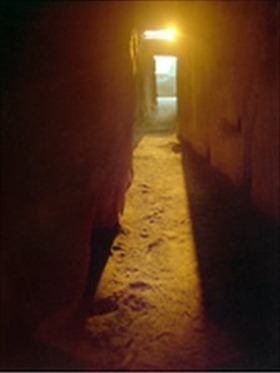 Newgrange, located 40km north of Dublin and perched high above a bend of the River Boyne, is a prehistoric passage tomb, covered on the outside by a large grassy mound.
Newgrange, located 40km north of Dublin and perched high above a bend of the River Boyne, is a prehistoric passage tomb, covered on the outside by a large grassy mound.
At over 5,000 years old it is the older cousin of Stonehenge and it predates the pyramids by about 500 years.
It is difficult to estimate how long it would have taken to build it.
"They were a very sophisticated society with a sound economic base as they were able to divert a large number of people to the building of passage tombs," says archaeologist Professor George Eogan.
"The ritual of the dead was very important in their lives and the site combines engineering, architectural and artistic skills."
Shaft of light
Newgrange is unique because the builders aligned it with the rising sun.
Just after sunrise, at 0858GMT, on the shortest day of the year, the inner chamber is designed to flood with sunlight, which enters through a 25cm (9.9ins) high "roof box" above the passage entrance.
Unfortunately this year heavy snow clouds prevented the sun from entering through the roof box.
Demand to attend the midwinter solstice is high and since 2000 it has been regulated by a lottery system. This year, more than 25,000 people applied but only a handful were selected to attend on 21 December and the days around the solstice.
The lucky winners - drawn by primary school children from three local schools - included people from Ireland, the US, England, Scotland, Sweden and the Czech Republic.
Danielle Lacava from Pittsburgh in the US was one of the lucky lottery winners and she travelled to Newgrange with her brother Chris.
"There was a lot of anticipation building up for what you hoped was going to happen. Even though we didn't see the sun it was still nice to be there."
When their flight from London was cancelled the Lacavas travelled by ferry and train to be there for the special event. Danielle would love to see the sun enter the chamber but thinks perhaps her luck had run out
"Maybe I'll put Chris's name in the lottery and see if he can win it now!"
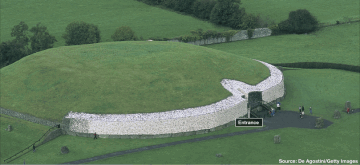
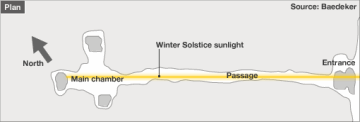
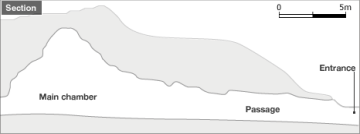 The solstice phenomenon was discovered by archaeologist, Professor Michael J O'Kelly on 21 December 1967 during research on the site.
The solstice phenomenon was discovered by archaeologist, Professor Michael J O'Kelly on 21 December 1967 during research on the site.
"He found the roof box when uncovering the roof chamber but wondered about its purpose," says his daughter Helen Watanabe O'Kelly.
Local people always said it was aligned to the sun but the measurements did not fit the summer solstice.
"My mother, who worked closely with him, suggested that it might be connected with the winter solstice. And that was how he discovered it in 1967."
Ms O'Kelly recalls how she experienced it with him the following year.
"There were just the two of us. It was cold and dark - no razzmatazz, like you have now. I still remember sitting in the cold and we just waited.
"Suddenly this shaft of light came into the chamber and hit the back wall. I remember being quietly moved - it was like someone was speaking to you from thousands of years before. I still see it like a picture before my inner eye - it was a golden light."
Since the discovery of the winter solstice alignment, Newgrange has been developed as a major tourist attraction and was listed as a UNESCO World Heritage Site in 1993.
Clare Tuffy, the visitor centre's manager who has worked at Newgrange since the early 1980s, keeps the guests outside for as long possible on the solstice morning.
Even though the passage way and chamber are only 24m (78ft) long, once you enter you are cut off from the outside world and lose a sense of time passing.
"When the sun clears the horizon you can hear a big cheer from those gathered outside.
"We have to wait four minutes after sunrise to experience the light entering the chamber because the earth's angle has changed since it was constructed 5,000 years ago. The light remains in the chamber for 17 minutes before retreating."
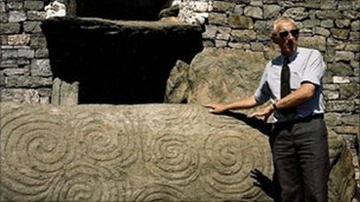 The centre's staff do not orchestrate what happens in the chamber. Sometimes people ask to sing a song, say a poem or chant, but any activity is done with the agreement of the group.
The centre's staff do not orchestrate what happens in the chamber. Sometimes people ask to sing a song, say a poem or chant, but any activity is done with the agreement of the group.
Those not lucky enough to get a place in the draw are welcome to gather outside and in spite of the freezing temperatures, there was a good crowd to celebrate the solstice.
People are motivated to come by the symbolism of the light and dark and the turning of the year. Some have made it a tradition and come year after year. Druids also assemble outside, chanting and singing.
Even though she is a veteran of the experience, Clare Tuffy is still moved by it and she is keen to make it special for the lottery winners.
"I get very excited and anxious every year that it will all go well. My husband calls it 'solstice fever'. It starts in early December and doesn't finish until Christmas."
Lunar eclipse
Irish weather is frequently inclement, but there were no drips inside Newgrange to dampen the enthusiasm of the solstice watchers.
The ancient engineers designed it to be waterproof, packing sand and burnt soil among the roof stones and even cutting channels into them to direct water away from the passage and chamber.
But the privileged few who will come to marvel at this masterpiece of human creativity are counting on "third time lucky".
The past two years have been cloudy and overcast on 21 December, which means the chamber remains in darkness. This year they hope for clear skies and a bright solstice sunrise.
To add extra excitement to this year's experience there was also a lunar eclipse on the morning of the 21st. It was visible until shortly before the group entered the chamber, and it was the first time in over 450 years that a lunar eclipse and the winter solstice had coincided.
For those gathered, the snow overshadowed the visibility of both the eclipse and the solstice.
But there was still much joy in the chamber and as people left, they marvelled at the beauty of the ancient landscape as the snow began to fall.
Author: Trish Flanagan | Source: BBC News [December 21, 2010]